Assessment of groundwater quality - A case study of Kondapur mandal, Medak district, Andhra Pradesh
k. Ramamohan Reddy1 and R. S. Patode1
1
Centre for Water Resources,
Jawaharlal Nehru Technological University,
Hyderabad,
500085
India
DOI: http://dx.doi.org/10.12944/CWE.8.2.12
Copy the following to cite this article:
Reddy K. R, Patode R. S. Assessment of groundwater quality - A case study of Kondapur mandal, Medak district, Andhra Pradesh. Curr World Environ 2013;8(2) DOI:http://dx.doi.org/10.12944/CWE.8.2.12
Copy the following to cite this URL:
Reddy K. R, Patode R. S. Assessment of groundwater quality - A case study of Kondapur mandal, Medak district, Andhra Pradesh. Curr World Environ 2013;8(2). Curr World Environ 2013;8(2). Available from: http://www.cwejournal.org/?p=4426
Download article (pdf) Citation Manager Publish History
Select type of program for download
| Endnote EndNote format (Mac & Win) | |
| Reference Manager Ris format (Win only) | |
| Procite Ris format (Win only) | |
| Medlars Format | |
| RefWorks Format RefWorks format (Mac & Win) | |
| BibTex Format BibTex format (Mac & Win) |
Article Publishing History
| Received: | 2013-04-18 |
|---|---|
| Accepted: | 2013-06-06 |
Groundwater quality assessment is important in order to ensure sustainable safe use of water. Water quality index, based on some very important water quality parameters, can provide a simple indicator of water quality at a certain location and time. Ramakrishnaiah et al., (2009) calculated the water quality index (WQI) for the groundwater of Tumkur taluk. Yogendra K et al., (2007) worked out the water quality index of an urban water body, Gopishettykere, in Shimoga Town, Karnataka in order to ascertain the quality of water meant for public consumption, recreation and other purposes. Kavitha et al., (2010) aimed at minimizing the adverse impacts likely to occur due to water pollution as a consequence of rapid industrialization and population growth in Erode District of Tamilnadu. Sinha et al., (2006) made an effort towards assessing drinking water contamination and variation of drinking water quality after the onset of monsoon at Hasanpur, J. P. Nagar, on the basis of calculated values of water quality indices. Once the groundwater is contaminated, its quality cannot be restored by stopping the pollutants from the source. Therefore it becomes imperative to regularly monitor the quality of groundwater and to device ways and means to protect it. Water Quality Index (WQI) is a unit-less number that expresses overall water quality at a certain location and time based on several water quality parameters. The main objective of this work is to assess the groundwater quality of Kondapur mandal of Medak District, Andhra Pradesh, based on the available physicochemical data and the analytical results of groundwater samples.
Study Area
The study area comprises of Kondapur mandal of Medak district, which lies between 17o 25’ 0” and 17 40’ 0” North Latitudes and 77o 55’ 0” and 78o 5’ 0” East Longitudes. The mandal comprises of 23 revenue villages having an area of 149.1 Sq. Km. It is at an elevation of 525 m above MSL. The mandal headquarters (Kondapur) is located at 69 Km from Hyderabad. It comes under Sangareddy revenue division and is located along the national highway 9 between Sangareddy and Sadasivpet mandals of the same division. The rainfall distribution of Kondapur mandal for the period from 2000 to 2009 is shown in figure 1. While the normal rainfall of the area is 802 mm, the actual rainfall received ranges from a minimum of 348 mm in 2004 to a maximum of 1055.7 mm in 2005, in the period of 10 years.
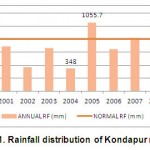 |
Figure 1: Rainfall distribution of Kondapur mandal Click here to View figure |
Methodology
The data required for water quality analysis in the present study has been obtained from Rural Water Supply and Sanitation Department of Government of Andhra Pradesh. The data pertaining to the test results of the water samples analyzed from the groundwater sources of various villages in Kondapur mandal from 2007 to 2010 (4 years) have been collected for the study. The analytical data of the samples (171) collected during the post monsoon period of 2009 (July to Dec) from all the villages of Kondapur mandal have been used to assess the groundwater quality of the area through the determination of WQI, comparison with BIS:10500-1991 for drinking water and statistical analysis. For studying the variation of water quality in pre and post monsoon periods, analyzed data of the samples (498) collected both during pre and post monsoons periods for the four years in 9 villages of the mandal were considered. Abstract of this data is given in table 1.
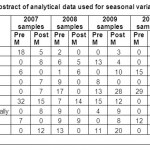 |
Table 1: Abstract of analytical data used for seasonal variation studies Click here to View table |
Resuls and Discussion
Groundwater occurs under phreatic conditions in shallow weathered mantle and under semi confined conditions in the fractured zones. In weathered granite and alluvium, the transmissivity values ranges from 100 to 150 sq.m/day and the specific capacity ranges from 0.005 to 0.16 cu.m/m per unit cross-section. Groundwater in basaltic and lateritic formations of Deccan traps occurs under water table and semi-confined conditions. The transmissivity values of these formations range between 100 and 1100 m2/ day and the specific capacity varies from 0.22 to 1.2 m3/m draw down. Water has become a scarce resource here not only due to deficient rainfall but also due to over exploitation of groundwater. Water Quality Index (WQI): The assessment of groundwater quality in the given area and its suitability for human consumption is computed based on water quality index values. The average value of each of the six water quality parameters (TDS, pH, TA, TH, Cl and F) for every village has been computed from the individual sample values and given in table 2. The WQI for each village is also calculated by sub index method (SI method) and from the computed WQI values the groundwater is classified into two types, “good water” and “poor water”. The representation is shown in figure 2.
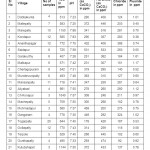 |
Table 2: Mean values of different water quality parameters of different villages of Kondapur mandal Click here to View table |
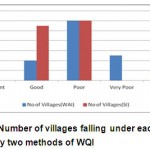 |
Figure 2: Number of villages falling under each category by two methods of WQI Click here to View figure |
Based on the water quality index values obtained by Weighted Arithmetic Index Method (WAIM), the groundwater in various villages of Kondapur mandal is categorized as Unfit for drinking in Garakurthy and Malkapur. Very Poor in Dobbakunta, Aliyabad, Ch Konapur, Gangaram and Gunthapally. Poor in Marepally, Ananthasagar, Saidapur, Munidevunipally, Mansanpally, Machepally, Mohmadapur, Gollapally, Terpole, Kutubshapet, Girmapur and Haridaspur. Good in Mallepally, Kondapur, Ch Gopularam and Togarpally. Based on the water quality index values obtained by Sub Index Method (SIM), the groundwater in various villages of Kondapur mandal is categorized as Good in Dobbakunta, Mallepally, Kondapur, Ch Gopularam, Munidevunipally, Machepally, Togarpally, Gollapally, Terpole, Gunthapally and Haridaspur. Poor in Marepally, Ananthasagar, Saidapur, Garakurthy, Malkapur, Mansanpally, Aliyabad, Ch Konapur, Mohmadapur, Gangaram, Kutubshapet and Girmapur.
Suitability of groundwater for drinking as per BIS: 10500-1991
The suitability of groundwater in the study area for drinking purposes has also been analyzed with respect to the individual values of pH, TDS, TA, TH, Cl and F. The values of these parameters/concentrations of chemical constituents have been compared with the standards prescribed by the Bureau of Indian Standards for the purpose (Yadav et al., 2010). Table 3, shows the desirable and permissible limits for each of the above constituents as per BIS: 10500 - 1991and the percent samples within each limit and exceeding the limit.
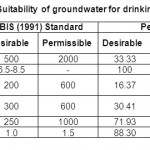 |
Table 3: Suitability of groundwater for drinking Click here to View table |
The results of the analysis indicate that the groundwater in major part of the study area is suitable for drinking. However, excess concentrations of total hardness and fluoride are likely to pose constraints in the use of water for drinking in parts of the area. The number of villages exceeding the maximum permissible limits laid for each water quality parameter is represented in figure 3.
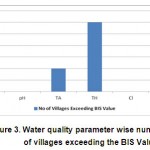 |
Figure 3: Water quality parameter wise number of villages exceeding the BIS Value Click here to View figure |
From the analysis it is observed that, of the total 23 villages, all water quality parameters are well within the maximum permissible values laid by the BIS in 10 villages. In the remaining 13 villages also the parameters pH and chloride have not exceeded the above limits. 6 villages are not safe with respect to each of the parameters, fluoride and total Hardness. 2 villages and 1 village are not safe with respect to total alkalinity and total dissolved solids respectively. Statistical analysis of data: Important statistical parameters of concentrations of various chemical constituents of groundwater of the area during post monsoon period of 2009 are shown in table 4. The data shows that there is considerable variation in the concentrations of all the constituents in the area, which may be due to a host of factors including soil type, land use, geology, geomorphic set up, human activities (like open dumping of solid wastes, open defecation, water stagnation around drinking water sources, use of fertilizers for agriculture, etc.) and the extent of dissolution of minerals during the process of rock-water interaction. (Sundara Kumar et al., 2010). The Parameters, which are analyzed during water analysis, are pH, conductivity, turbidity, chlorides, total alkalinity, fluoride, nitrate, iron.
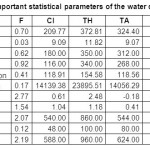 |
Table 4: Important statistical parameters of the water quality data Click here to View table |
The groundwater in the major part of the area is fresh with TDS in the range of 178 to 1000 mg/L. In the villages of Gollapally and Marepally the alkalinity values are found to exceed the permissible limits of 600 ppm. The total hardness data of the samples indicate that the groundwater is only moderately hard (75-150 ppm) to hard (150-300 ppm) in respect of 30 % of samples and 70 % of the samples are found to be very hard (>300ppm). The chloride content ranges from 48 to 588 mg/L. However in some villages where it is above 250 ppm, salty taste to drinking water is imparted and thus water becomes objectionable for drinking. The concentration of Fluoride in the study area varies from as low as 0.12 mg/L to as high as 2.19 mg/L. However, about 88% of the samples have fluoride concentrations within the desirable limit of 1mg/L and only 7.6 % of the samples exceed the permissible limit of 1.5 mg/L. Seasonal Variation of Water Quality: Seasonal variations of groundwater quality in 9 villages of the mandal have been studied using the water quality data (498 samples) collected from bore wells from pre-monsoon (2007) to post-monsoon (2010) periods and it is noted that the pH and chloride values are well within the range for drinking purpose both during pre and post monsoon seasons for all the nine villages. Other observations are presented in table 5.
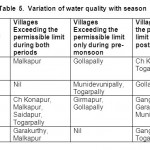 |
Table 5: Variation of water quality with season Click here to View table |
Conclusion
Considering all the six parameters of drinking water, it is found that more than 84 % of samples collected from the study area have all the constituents well within either desirable or permissible limits of BIS: 10500-1991 and hence safe for drinking purpose. By analyzing the data of 498 samples of 9 villages, pertaining to both pre and post monsoon seasons for the period 2007 to 2010, it is concluded that, the quality of groundwater in these villages is changing from season to season. Hence continuous monitoring of groundwater quality is essential in order to supply potable water to the rural people.
References
- CGWB, Southern Region, Hyderabad. (2007). Groundwater Information, Medak District, Andhra Pradesh.
- Kavitha, R. and Elangovan, K. (2010). Groundwater quality characteristics at Erode district, Tamilnadu India. International Journal of Environmental Science I( 2) :145-150.
- Ramakrishnaiah, C. R., Sadashivaiah, C. and Ranganna, G. (2009). Assessment of water quality index for the groundwater in Tumkur Taluk, Karnataka State. E-Journal of Chemistry. 6(2) : 523-530.
- Shah, M. C., Shilpkar, P. G. and Acharya, P. B. (2008). Groundwater quality of Gandhinagar Taluka, Gujarat, India. E- Journal of Chemistry. 5 (3) : 435-446.
- Sinha, D. K. and Ritesh Saxena. (2006). Statistical assessment of underground drinking water contamination and effect of monsoon at Hasanpur, J. P. Nagar Uttar Pradesh. Journal of Environment, Science and Engineering. 48 : 157-164.
- Subba Rao Chandaluri, Sreenivasa Rao, B., Hariharan, A. and Manjula Bharathi, N. (2010). Determination of water quality index of some areas in Guntur District, Andhra Pradesh. International Journal of Applied Biology and Pharmaceutical Technology I-1:78 – 86.
- Sundara Kumar, K., Sundara Kumar, P., Ratnakanth Babu, J. and Hanumantha Rao. (2010). Assessment and mapping of goundwater quality using Geographical Information Systems. International Journal of Engineering, Science and Technology 2 (11) : 6035-6046.
- Yadav, A. K., Khan, P. and Sharma, S. K. (2010). Water quality index assessment of groundwater in Todaraisingh tehsil of Rajasthan State, India-A Greener Approach. E-Journal of Chemistry. 7(SI): S428-S432.
- Yogendra, K. and Puttaiah, E. T. (2007). Determination of water quality index and suitability of an urban water body in Shimoga town of Karnataka. Proceedings of Taal, 2007, The twelfth World Lake conference, pp 342-346.







